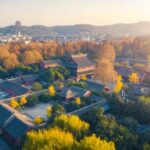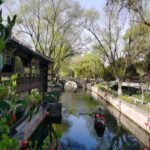Taibai Tower is located one kilometer southwest of the ancient town of Caishi Jie, facing the Yangtze River and backed by Cuiluo Mountain. It is a magnificent ancient building surrounded by lush greenery. Along with Yueyang Tower in Hunan, Yellow Crane Tower in Hubei, and Tengwang Pavilion in Jiangxi, it is known as the ‘Three Towers and One Pavilion’ of the Yangtze River, and has long been referred to as ‘Storing the Wind and Moon of the River Sky in One Building’.
The original name of Taibai Tower was Zhe Xian Tower. According to historical records, it was first built during the Yuanhe period of the Tang Dynasty, but due to the simplicity of the records, the details are not clear. The earliest confirmed construction date is the fifth year of the Zhengtong era of the Ming Dynasty. In that year, Zhou Zhen, the Right Vice Minister of the Ministry of Works, ordered the monk Xiu Hui of Guangji Temple to build Qingfeng Pavilion in front of the temple, and at the same time, built Zhe Xian Tower in front of the temple, where a statue of Taibai was enshrined for worship. In the first year of the Kangxi era of the Qing Dynasty, Hu Jiyong, the prefect of Taiping, rebuilt it and renamed it ‘Taibai Tower’. He also moved the Li Bai Temple next to the Shenxiao Palace to this location, forming a layout of a pavilion and a wall. During the Xianfeng period, it was destroyed by war. The existing Taibai Tower was rebuilt by Peng Yulin, the Right Vice Minister of the Ministry of War, in the third year of the Guangxu era. After the founding of New China, it has been renovated several times and has taken on a new look. Taibai Tower is 18 meters high, 34 meters long, and 17 meters wide, with a three-story main building, the first floor being a hall, the second floor a tower, and the third floor a pavilion. It is divided into two courtyards, the front being Taibai Tower and the back being Taibai Temple. The first floor of the main building is built with bluestone, and the second and third floors are wooden structures. The eaves are inlaid with golden trim, and the hip roof is covered with yellow glazed tiles. The drip tiles are decorated with carvings of fish and animals, the shape is elegant and ancient, and it is tall and spectacular, giving a solemn and dignified feeling. On the door lintel of Taibai Tower, there is a blue background with golden characters ‘Tang Li Gong Qinglian Temple’, and a pair of stone lions on both sides of the door, finely carved and lively. Inside the door, the two walls of the corridor are embedded with the Qing Dynasty reconstruction records and Li Bai’s life stele. Under the eaves of the third floor, there is a hanging plaque with ‘Taibai Tower’ in strong calligraphy. Climbing the wooden stairs inside the tower to the third floor and looking out the window, you can see the Yangtze River like a ribbon and white sails dotted. Behind Taibai Tower is Taibai Temple. The temple follows the terrain, built on the slope, and is connected to the second floor of the front tower by a corridor. It is open all year round from 8:30 to 17:00.Taibai Tower
Taibai Tower is located one kilometer southwest of the ancient town of Caishi Jie, facing the Yangtz[...]









